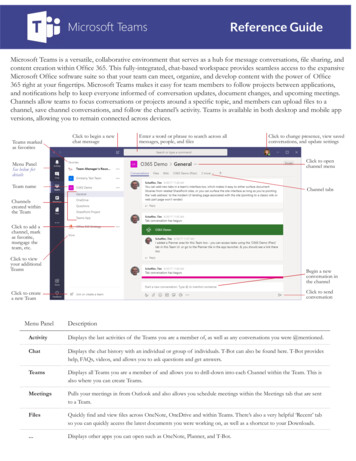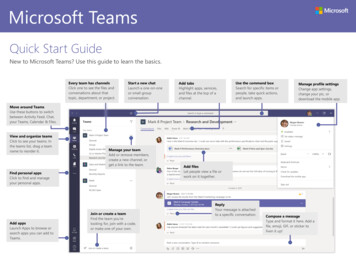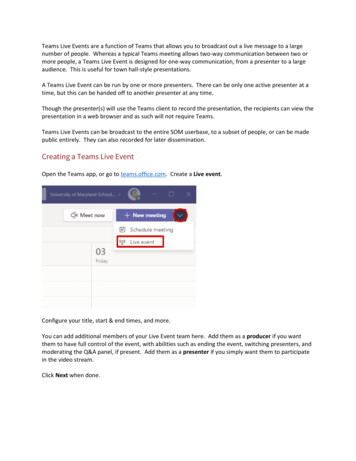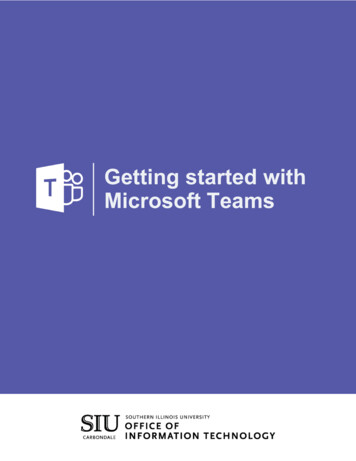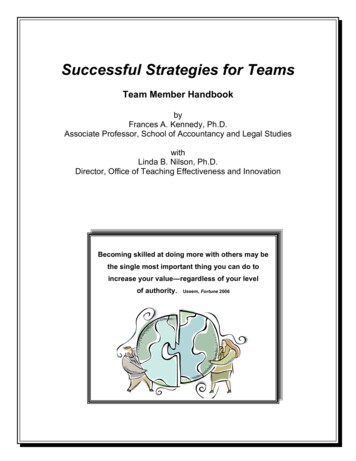
Transcription
Successful Strategies for TeamsTeam Member HandbookbyFrances A. Kennedy, Ph.D.Associate Professor, School of Accountancy and Legal StudieswithLinda B. Nilson, Ph.D.Director, Office of Teaching Effectiveness and InnovationBecoming skilled at doing more with others may bethe single most important thing you can do toincrease your value!regardless of your levelof authority.Useem, Fortune 2006
niversity!!! !Frances!A.!Kennedy,!2008!!!Teaming HandbookPage2
Table of ContentsPART 1: Introduction. 4Why Should I Learn to Team?PART 2: Teaming Basics. 10Stages of DevelopmentTeam PlayersTeamwork Mental ModelsTeamwork SkillsPART 3: Organizational Tools . 36PART 4: Problem-Solving Framework . 53PART 5: Analysis Tools . 58PART 6: When Something Goes Wrong . 78PART 7: References . 88Whenever you see this box, youcan find a template to help youwith the tool!Download this Exceltemplate at:www.clemson.edu/OTEI/ResourcesTeaming HandbookPage3
PART 1.INTRODUCTIONThe purpose of this handbook is to equip you with tools that can help your teamwork productively and successfully. These techniques will help your teamorganize information, organize and run effective meetings, and generate usefulmember contributions.Objectives for YouAfter you read and start using this handbookin your team work, you will be able to:! Recognize different team player stylesand what each contributes to the team.! Organize a new team with clearground rules, roles, andresponsibilities.! Organize and run effective team meetings that stay on track.! Practice project and time planning.! Follow the Seven Steps of Problem-Solving.! Apply more qualitative and quantitative analysis techniques solvingproblems.! Know when and how to use the appropriate organizational andanalysis tools.Teaming HandbookPage4
WHY SHOULD I LEARN TO TEAM?FACTS:"81% of Fortune 500 companies are building at least partially teambased organizations, and at least 77% use temporary project teams toperform core work. Lawler, Mohrman, & Benson, 2001."In 2006, Fortune Magazine devoted an entire issue to teams June 12, 2006.It is clear from the media and research that a growing number of companies areorganizing their work around teams.But why?And what does it mean to me?An increasing number of companies are usingbusiness teams to respond quickly to changingconditions in an environment of intense globalcompetition and increasing complexity. Changingan organization to compete in a highly volatile business environment usuallyrequires multiple and continuous innovations. Achieving flexibility and innovationsrequires reorganizing into your work units to improve information flow, optimizesynergies, and streamline work.Teaming HandbookPage5
This is what traditional organizations have looked like –and this iswhat they arebecoming.In the traditionally organized organization, Cole has defined work responsibilitiesand receives his work instructions from his supervisor. He performs his workduties individually for the most part, and he alone is accountable for his workperformance.In the networked organization, Cole’s successful performance depends on hisinteractions with many of his coworkers. He is a member of a work teamexpected to achieve excellence by optimizing the value and use of all members’diverse skills and experiences. Therefore, Cole is both individually and jointlyaccountable for the team’s work product.Companies are actively recruiting graduates who canwork in this type of collaborative environment – peoplewho can work well with others, share responsibility, andget the job done efficiently!Teaming HandbookPage6
How prepared are you?Do you have the interpersonal skills to work productively on a team?Have you mastered the organizational skills to keep the team on track?Are you confident that you can manage a successful project?Working in student teams gives you the opportunity to acquire and practicethe collaborative skills that are essential to your future success.Teaming HandbookPage7
“Teamwork is an individual skill.”AVERY 2001Becoming skilled at doing more with others may be the single most importantthing you can do to increase your value--regardless of your level of authority.Useem, 2006Which of the following statements are true?1. “Since teamwork is a group experience, individuals can’t beresponsible for the quality of their team efforts.”2. “Getting in a good team is mostly a matter of luck.”3. “If you are in a poorly functioning team, andyou are not in charge,there is little you can dobut grin and bear it.”If you answered “True” to any of these statements, then chances are thatyou have had unfavorable team experiences. Past experiences influencehow people react when placed on a new team. You learn how to “act” and“interact” through past experiences. The “truth” is that these threestatements above are all myths!myths that many people believe inbecause they confirm their own prior experiences with teams.Teaming HandbookPage8
The reality is that positive team experiences come from:1. Using your individual personal abilities to enhance the entire team’seffectiveness.2. Knowing that being on a good team isn’t random. Rather, it is afunction of one’s relationship behavior and what you and others do.3. Taking personal responsibility for the quality of relationships and teamoutcomes.This handbook on teamwork is specifically designed to help you learn touse teamwork tools that will give you the collaborative skills you willneed to succeed in your career.-----The methods and tools included in this book are those taught bycorporate trainers and most commonly used across organizations.Teaming HandbookPage9
PART 2.TEAMING BASICSHaving a basic understanding of how teams work gives members a common wayof thinking about teams. It also helps set shared performance expectations andpromotes understanding and trust among team members.This section examines four important characteristics of teams:Stages of Team DevelopmentTeam PlayersTeamwork Mental ModelsTeamwork SkillsTeaming HandbookPage 10
STAGES OF TEAM DEVELOPMENTTeams Go Through Almost as certain as the sun rises in the east and sets inMultiple Stages ofthe west, all teams go through stages as they develop.DevelopmentWhat does vary is how long each stage takes.There are four stages of team development, and all teamslie somewhere along that continuum: Forming, Storming,Teamwork Skills Norming and Performing.Help TeamsProgressThrough Stages Some teams never progress past the second stage, whileother teams zip right through to the final stage.Key Points:! Team members should talk about theircurrent stage.!All teams go through rough patches at first.PERFORMINGNORMINGSTORMINGFORMINGTeaming HandbookPage 11
Stage 1: FORMING*This stage is characterized by introductions andCharacteristicssocializing activities. In some teams, members may besomewhat tentative and may not fully understand thepurpose of the team. But in others, they may get rightdown to identifying what each member can contribute tomeeting the objective and planning an agenda.COMMON FEELINGS# Excitement, anticipation, andoptimism# Pride in being chosen for theproject# Initial, tentative attachment to theteam# Suspicion, fear, and anxietyabout the job aheadCOMMON BEHAVIORS# Attempts to define the missionand decide how it will beaccomplished# Attempts to determine acceptableteam behavior and how toresolve problems within the team# Discussion of symptoms orproblems not relevant to the task;difficulty in identifying relevantproblems# Complaints about theorganization and barriers to thetaskRECOMMENDATIONS:! Discuss team expectations.! Useful Organizational Tools:Establish Ground Rules (pg 40)Define Team Roles and Responsibilities (pg 37)* Stage descriptions are adapted from Working Together Reference Manual from Rubbermaid, Inc.Teaming HandbookPage 12
Stage 2: STORMINGThis stage is characterized by individual assertiveness,Characteristicshidden agendas, conflict, and discomfort. Significant rolenegotiation is the undercurrent. This stage provides afoundation for effective interaction in the next stages.Cliques may form, and a struggle for leadership may takeplace. Individual members may be dissatisfied with theteam’s performance at this stage and may reflect thatfeeling with derogatory comments about the team.COMMON FEELINGS# Resistance to the missionand to approaches differentfrom those used by eachindividual member.# Sharp fluctuations in attitudeabout the team and theproject’s chance of success.COMMON BEHAVIORS#Arguing among memberseven when they agree onthe real issue# Defensiveness andcompetition; factions and“choosing sides”# Establishing unrealistic goals# Expressing concern aboutexcessive workRECOMMENDATION:! Communicate! Make sure everyone stays in the loop.! Useful Organizational Tools:Meeting Agendas and Summaries (pg 42 & 45)Project Planning Tools (pg 47)Teaming HandbookPage 13
Stage 3: NORMINGThe team begins to refocus on their task or objective andCharacteristicsto develop a team spirit. Leadership may be sharedamong group members. Problems are addressed asmutual rather than individual. Real progress toward theteam’s objective is made.COMMON FEELINGSCOMMON BEHAVIORS# A new ability to expresscriticism constructively## Acceptance of membershipto the team# More friendliness, confidingin each other, and sharing ofpersonal problems;discussion of the team’sdynamics# Relief that it seemseverything is going to workout.Attempts to achieveharmony by avoiding conflict# A sense of team cohesion, acommon spirit and goals# Establishing and maintainteam methods andboundaries (ground rules).RECOMMENDATION:! Continue using Organizational Tools.! Follow the Steps of Problem Solving (pg 53).! Use Appropriate Analysis Tools.Teaming HandbookPage 14
Stage 4: PERFORMINGMembers feel high morale within the team, loyalty to theCharacteristicsteam, and an identity that may be represented by a logo orname. Members may participate equally.COMMON FEELINGS# Insights into personal andgroup processes; betterunderstanding of eachother’s strengths andweaknesses# Satisfaction at the team’sprogressCOMMON BEHAVIORS# Ability to prevent or workthrough team problems# Close attachment to the team# Constructive disagreementused to resolve conflictingissues and ideasRECOMMENDATION:! Continue using Organizational Tools.! Follow the Steps of Problem Solving (pg 53).! Use Appropriate Analysis Tools.Teaming HandbookPage 15
TEAM PLAYERSEvery team member has a natural team-player style. All ofthese styles are important ingredients of successfulteams.Contributor This member gets the team to focus on the immediatetask.Collaborator This team player emphasizes the overall purpose of theteam.Communicator This member encourages positive interpersonal relationsand group processes.Challenger This style asks the tough questions and pushes the teamto take reasonable risks.It is important for a team to understand the team playerstyles of its members. This helps to highlight bothstrengths and weaknesses. And if a player style ismissing, then the team can talk about how to fill this gap.Which team player style are you?Teaming HandbookPage 16
Team Player Questionnaire**PurposeThe Team-Player Questionnaire will help you identify yourstyle as a team player. The results will lead you to anassessment of your current strengths and provide a basis for aplan to increase your effectiveness as a team player.Teams may use this questionnaire to develop a profile of team strengths and todiscuss strategies for increasing team effectiveness.DirectionsFirst, this is a questionnaire, and, therefore, there are no right or wrongresponses. Please answer each item according to how you honestly feel youfunction now as a team member rather than how you used to be or how youwould like to be.You will be asked to complete eighteen sentences. Each sentence has fourpossible endings. Please rank the endings in the order in which you feel eachone applies to you. Place the number 4 next to the ending which is mostapplicable to you and continue down to a 1 next to the ending which is leastapplicable to you.For example:As a team member, I am usually most concerned about:3 a. meeting high ethical standards.4 b. reaching our goals.2 c. meeting my individual responsibilities.1 d. how well we are working together as a group.Please do not make ties or use 4, 3, 2, or 1 more than once. It is possible thatsome of the sentences will have two or more endings that apply to you or willhave none that applies to you, but you should assume these are your onlychoices and rank them accordingly. Each set of endings must be ranked 4, 3, 2,and 1.** This questionnaire was developed by Glenn Parker and is found in the following book:Parker, G. M. 1996. Team Players and Teamwork. San Francisco: Jossey-Bass.Teaming HandbookPage 17
TEAM PLAYER QUESTIONNAIRE1. During team meetings, I usually:a. provide the team with technical data or information.b. keep the team focused on our mission or goal.c. make sure everyone is involved in the discussion.d. raise questions about our goals or methods.2. In relating to the team leader, I:a. suggest that our work be goal directed.b. try to help him or her build a positive team climate.c. am willing to disagree with him or her when necessary.d. offer advice based upon my area of expertise.3. Under stress, I sometimes:a. overuse humor and other tension-reducing devices.b. am too direct in communicating with other team members.c. lose patience with the need to get involved in discussions.d. complain to outsiders about problems facing the team.4. When conflicts arise on the team, I usually:a. press for an honest discussion of the differences.b. provide reasons why one side or the other is correct.c. see the differences as a basis for a possible change in team direction.d. try to break the tension with a supportive or humorous remark.5. Other team members usually see me as:a. factual.b. flexible.c. encouraging.d. candid.6. At times, I am:a. too results oriented.b. too laid-back.c. self-righteous.d. shortsighted.7. When things go wrong on the team, I usually:a. push for increased emphasis on listening, feedback, and participation.b. press for a candid discussion of our problems.c. work hard to provide more and better information.d. suggest that we revisit out basic mission.Teaming HandbookPage 18
8. A risky team contribution for me is to:a. question some aspect of the team’s work.b. push the team to set higher performance standards.c. work outside my defined role or job area.d. provide other team members with feedback on theirbehavior as team members.9. Sometimes other team members see me as:a. a perfectionist.b. unwilling to reassess the team’s mission or goals.c. not serious about getting the real job done.d. a nitpicker.10. I believe team problem solving requires:a. cooperation by all team members.b. high-level listening skills.c. a willingness to ask tough questions.d. good solid data.11. When a new team is forming, I usually:a. try to meet and get to know other team members.b. ask pointed questions about our goals and methods.c. want to know what is expected of me.d. seek clarity about our basic mission.12. At times, I make other people feel:a. dishonest because they are not able to be as confrontational as I am.b. guilty because they don’t live up to my standards.c. small-minded because they don’t think long-range.d. heartless because they don’t care about how people relate to each other.13. I believe the role of the team leader is to:a. ensure the efficient solution of business problems.b. help the team establish long-range goals and short-term objectives.c. create a participatory decision-making climate.d. bring out diverse ideas and challenge assumptions.14. I believe team decisions should be based on:a. the team’s mission and goals.b. a consensus of team members.c. an open and candid assessment of the issues.d. the weight of the evidence.Teaming HandbookPage 19
15. Sometimes I:a. see team climate as an end in itself.b. play the devil’s advocate far too long.c. fail to see the importance of effective team process.d. overemphasize strategic issues and minimize short-termtask accomplishments.16. People have often described me as:a. independent.b. dependable.c. imaginative.d. participative.17. Most of the time, I am:a. responsible and hardworking.b. committed and flexible.c. enthusiastic and humorous.d. honest and authentic.18. In relating to other team members, at times I get annoyed because they don’t:a. revisit team goals or check progress.b. see the importance of working well together.c. object to team action with which they disagree.d. complete their team assignments on time.Teaming HandbookPage 20
TEAM-PLAYER QUESTIONNAIRE RESULTSDirections:1. Please transfer your answers from the questionnaire to this page.2. Be careful when recording the numbers because the order ofletters changes for each question. For example, in question #1, the orderis a, b, c, d, but in question #2, the order is d, a, b, c.3. The totals for the four styles must equal atorb.a.d.c.b.a.d.c.b.a.d.c.b.a.d.c.b.a. Communicatorc.b.a.d.c.b.a.d.c.b.a.d.c.b.a.d.c.b. Challengerd.c.b.a.d.c.b.a.d.c.b.a.d.c.b.a.d.c. 180The highest number designates your primary team-player style. If your highestnumbers are the same or within three points of each other, consider them bothas your primary style. The lowest total indicates your least active team-playerstyle.Your primary team-player style defines a set of behaviors that you use most oftenas a member of a team. It does not mean that it is the only style you use. All ofus have the capacity to use any one of the four styles. We simply use onestyle!our primary style!most often.Teaming HandbookPage 21
Are you a Contributor?Enjoys providing good technical information and data.Pushes for high performance standards.Helps the team use its time and resources.Freely shares all relevant information with the ticClearTeaming HandbookSystematicPage 22
Are you a Collaborator?Helps the team establish goals and clarify tasks.Sees the “Big Picture.”Reminds the team to stay on track and focused on the target.Pitches in to help out other team members when needed.Flexible and open to new naryForward-lookingAccommodatingTeaming HandbookPage 23
Are you a Communicator?Emphasizes team process.Believes in an interpersonal “glue”.Listens well and periodically summarizes discussion.Encourages everyone to participate.Helps team members relax and have FriendlyTeaming HandbookHelpfulPage 24
Are you a Challenger?Questions goals and methods.Willing to disagree with the leader.Encourages the team to take well-conceived risks.Honest about progress and problems.Asks “why?” and ‘how?” and other relevant ledOutspokenTeaming HandbookHonestPage 25
Styles Working TogetherYou probably discovered you have a primary and asecondary team player style. These are the stylesyou usually use when on a team.You may have scored closely on more than oneplayer style. You might have even scored closely onall four styles. That is okay! This just means thatyou are versatile and will tend to draw on thepersonality traits as needed.The GOAL is to have a goodmix of team player styleson the team.All FOUR styles are needed to havea really great team.-----EVERYONE has valuable skills to bringto the table!Teaming HandbookPage 26
Too much of a good thing . . .Teams with members who have similar styles may sometimes have troublereaching their goals.If a team has only . . . . . contributors,it may be data-bound, shortsighted, perfectionist, and may havetrouble completing the whole task. . . collaborators,it tends to become overcommitted, too global, and overly ambitious,and it does not know when to stop. . . communicators,it focuses on the team processes and may set these as an end in itself,with the project goals taking second place. . . challengers,it spends a great deal of time in non-constructive conflict,constantly questioning the goals and mission, and finds it difficultto complete the project tasks.Teaming HandbookPage 27
What if the teamdoesn’t have aneven mix?What if the teamis missing astyle?HINT: TALK about the team’sstrengths and limitations!! What qualities and skills is theteam missing?! How can the team adjust?Recognizing and talkingabout weaknesses can beyour team’sBIGGEST strength!Teaming HandbookPage 28
TEAMWORK MENTAL MODELSA “teamwork mental model” is an individual member’sunderstanding about what is needed for a team to besuccessful. Each team member comes to a team with apre-determined model (or picture) of how teams workthat is influenced by prior experiences.Team members come to the first team meeting withThe Sooner YouDevelop GoodTeamwork Skills,the Better YourCollege TeamExperience Will Bedifferent mental models of team processes. Whenmembers have similar team-related knowledge ofprocesses, then they are better able to coordinate theirwork and achieve higher performance. They cananticipate the actions and information needs of theirteammates.Your experiences with teams contribute to thethe teamwork mental model that you will takewith you to your first job.-----Positive experiences will generate a positiveattitude and energy as you developcollaborations during your career.Teaming HandbookPage 29
TEAMWORK SKILLSExperienced team members develop two distinct butrelated sets of skills:Interpersonal SkillsMeeting Management SkillsInterpersonal skills involve the ability to interact in apositive and effective manner with other team members.Effective Communication and Collaborative DecisionMaking are two important interpersonal skills. Theyenable a team member to communicate openly andsupportively.Four Guidelines for Effective Communication1. Focus on the behavior or problem, not on the person. People becomedefensive when criticized personally. Keep the discussion focused on the taskand the issues.2. Make sure what you say and what you do are the giving the samemessage. In other words, keep your verbal and nonverbal language on thesame page. This limits confusion.3. Validate others’ contributions. Compliment team members on good ideasand suggestions. This makes them feel a part of the team and encouragesfuture participation.4. Make sure everyone has a chance to speak. Encourageteam members to express opinions and share ideas.Don’t let specific team members dominate theconversation. Ideas are lost this way.Teaming HandbookPage 30
Collaborative Decision-MakingDecisions made by multiple individuals who openly share data,Why doopinions, and experiences are almost always better, morecompanies useteams to solve innovative, longer lasting decisions that those made my aproblems?single individual.It’s because of the diversity ofexperiences and opinions!Sometimes the process is harderbecause people see things differently. But ifeveryone thought the same way, then the decision would notbe very innovative at all!Imagine what team members thought when someone said forthe first time,“Let’s give free flights to people who fly frequently.” (Maginn 1994)Probably some people thought:“No one will buy this!”“We’ll lose money!”“What a crazy idea!”“We’ll get fired if we suggest this!”But as the team members began to talk about it, they began tosee new possibilities. Now it doesn’t seem like such a crazyidea after all, does it?Teaming HandbookPage 31
Once upon a time . . .In his book, Shadows of the Neanderthal, David Hutchens tells the story of twocavemen who went outside the cave to see what the world was like. Each onewent in a different direction, climbed a tall tower and looked out over the world hecould see. Then each one came back to the cave to report what he had seen tothe rest of the tribe.Caveman #1 said,“We must build spears so we can hunt for ourfood if we are to survive.”Caveman #2 screamed,“No! We must build tools so we can plantand grow our food. Only then can we survive.”What did each one see from each of their towers?This is what Caveman #1 saw:But this is what Caveman #2 sawfrom his tower.Who is right?Should the tribe build spears or hoes?The answer, of course, is that they are BOTH right! But they would have to listento each other to understand why their viewpoints were different.Teaming HandbookPage 32
Compromise versus ConsensusA compromise is one way of arriving at a decision thatWhat is a everyone involved can accept. The benefit to compromisingCompromise?is that it is expedient and allows the team to move on to thenext task. In some situations, this is exactly what is needed.Synonyms forThe problem with compromising is that the outcome doesn’tcompromise:meet anyone’s expectations. Still, some people are happierSettlement with it than are others. As a result, not everyone is 100%ConcessionArrangement committed to the solution, so not everyone will work towardsimplementing the decision.When decisions are determinedby majority or authority, thosewho dissent lose theircommitment.In a consensus, the various points of view of each member ofthe team are considered, discussed, compared, andWhat is aConsensus? discussed again until everyone sees all ”views from thetower.” They may not all agree, but it is important that theiropinions are all heard.Synonyms for Why is building consensus important?consensus:The benefit to building consensusAgreement when making a decision is thatAccord everyone buys into the solution. ThisHarmonymeans that all team members will workUniontowards making that solution work.Teaming HandbookPage 33
Sometimes people in the minority may not feel comfortable jumping inand expressing their own opinion. How do you get them to offer theirideas and reasons?The key to consensus building is steering thediscussion away from “right versus wrong”arguments.-----Instead, seek different opinions and . . . listen!“How can we change this proposal soit works for you?”Avery, 2001Nominal Decision Making (pg 63) is one way of sorting all everyone’sopinions. When it looks like most people agree with one plan of action, youcan check for consensus by asking team members which of thestatements on the continuum below is closest to what they think (Avery 2001).Now, you can ask team members who don’t agree with one plan of actionwhat their reservations are all about.Unqualified yes.Move forward.12I can live with thedecision of thegroup.I think more work isneeded beforedeciding.Move forward.Do not moveforward.3456The point of thisexercise is to includethose who disagree.Inclusion givesdissenters a voice,which is alwaysbetter than no voiceat all!Perfectlyacceptable.I trust the group and willnot block this decision,but I need to registermy disagreement.I do not agree and feelthe need to stand inthe way of adoptingthis decision.Move forward.Move forward.Do not move forward.Teaming HandbookPage 34
Meeting Management SkillsMeeting Management skills are criticalfor a team to achieve its goals. The ability toplan and run a productive meeting is one that is learnedthrough practice and by using appropriate management tools.Mastering organizational and analysis tools will help yourteam to:! Hold productive meetings that start and end ontime.! Come to meetings prepared with materials andinformation.! Maintain good communication and records soeveryone knows what the team is doing.! Hold team members accountable for their assignedtasks.! Share the workload evenly.! Plan your project assignment.! Organize information to make it useful.! Gauge the team’s progress towards completing theassignment.AND . . .! Have a GREAT teamexperience!Teaming HandbookPage 35
PART 3.ORGANIZATIONAL TOOLSEffective team meetings are perhaps the single most important ingredient in teamsuccess. While individuals contribute much, their meeting together as asynergistic team produces even more. A well-run meeting not only accomplishesits task goal but motivates and excites team members. A meeting that is notproductive due to poor planning or conflict has just the opposite effect on teammembers. They lose confidence in their ability to succeed, and many choose toparticipate only minimally.In order for meetings to be productive, it is important to create and maintain afocus on both the team members and the task. Organizational tools help keepthe team on task and elicit member participation.Teams should use some tools when first organizing:! Establishing Roles and Responsibilities! Establishing Ground Rules.Teams should use other tools at every meeting tomaintain focus and effectiveness:! Meeting Agenda! Meeting Summary.Teams should use still other tools as needed to keep projects on track:! Project Plan! Gap Analysis! Milestone Chart.The following sections explain these tools.Teaming HandbookPage 36
ESTABLISH ROLESDiscussingRoles andResponsibilitiesEstablishesCommonExpectationsIt is important for every team member to activelyparticipate in the teaming process. Only in this way candiverse skills and opinions contribute to the bestoutcome. At times, some team members come tomeetings but don’t participate in discussions or volunteerfor tasks. These are “passive” members who may wantto contribute but need encouragem
Every team member has a natural team-player style. All of these styles are important ingredients of successful teams. Contributor This member gets the team to focus on the immediate task. Collaborator This team player emphasizes the overall purpose of the team. Communicator This member
